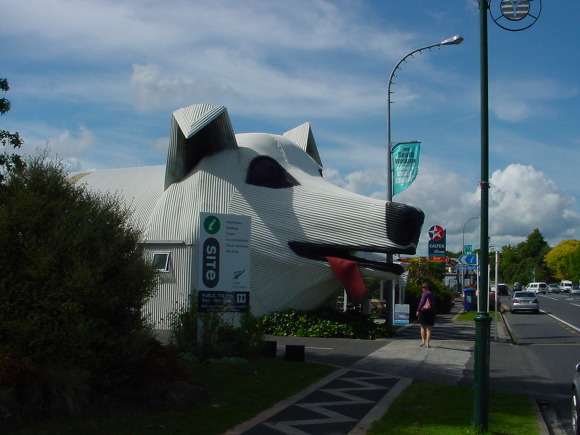20/3/11
After a morning visit to Tauranga’s urban Fernbirds most of the day was spent doing touristy things on the way to Raglan, such as the corrugated town of Tirau and the old buildings of Cambridge (from the car). A short detour was made to Hamilton Lake with its Coots, Pukeko and Swans – all of which seem out of place in so urban an environment. After walking around Raglan and seeing a great print called Buller’s Birds where the great man is festooned with, well, birds (I could neither afford nor transport the thing round the rest of NZ so there in the shop it remained), I was given time off close to dusk to visit the shit pits and the adjacent creek. Unfortunately the better shit pit of the two had gone and the remaining one had little on it (and required a wade through knee-deep kikuyu grass followed by a swampy-patch-dodge to get to it) and, apart from a suspicious call, the Banded Rails across the road from it kept themselves scarce.
21/3/11
Yesterday was Sunday and the local populace using the weekend to bathe in the dirty-looking river and sands (mud?) near the footbridge were gone. Today the Reef Heron was back on its regular beat and was the first bird seen on driving out of the camp ground. We head first west to see the surfies catching their waves on a birdless Tasman, then east. Just before turning south I see three white birds flying ahead almost adjacent to SH23. Given the terrain I think Cattle Egret, but a closer view shows them to be Sulphur-crested Cockatoos. They were close to the Karakariki Road intersection.
At the self-proclaimed Kiwiana Capital a stop at the kiwi house gives me my first sighting of Great Spotted Kiwi. I’ve heard plenty but this dratted species has escaped my eyes every time in the wild. This one doesn’t count of course, but it’s good to see what a moving, breathing one looks like. In the aviary a Grey Teal helpfully poses perched atop its identification plaque.
Lake Ngaroto is a peat lake close to Te Awamutu circled by a walking track. It has a reputation for crake records. We park, walk out to the start of the boardwalk, I play Spotless Crake tape and a real bird immediately answers. The boardwalk is a bit of a fairground ride in places at it floats on the swamp, sometimes with a definite list to starboard.
22/3/11
The morning is spent in backcountry Taranaki, starting at Mokau Whitebait Inn (where we spent the night, with only one vanload of pommie tourists looking for a cheaper camp ground out of the city being the other occupants). The river mouth holds little apart from a VOC and a lame SIPO. We do the Forgotten World Highway. Stopping at the Hobbit Hole (aka the Moki Tunnel) Robin and Whitehead could be heard among commoner forest birds. Robin was also heard at the top of the saddle along SH23 S of Whangamomona.
In the late afternoon we visited Pukekura Park with its well laid out grounds, Tui, Scaup, and 3 Canada Geese – the latter the starting of the scourge in New Plymouth.
23/3/11
Hyeza and Olivia looked around Puke Ariki whilst Peter Fryer showed me around the local hotspot – the Waiongana RM. It’s an interesting wee estuary and lagoon, and regular visits by Peter often turn up good birds. We saw a fly-over Pacific Golden Plover and mollymawks out at sea, amongst more ordinary fare
The mountain this morning had its head out of the clouds most of the time, with just wisps affecting its southern slopes. We make for The Plateau through the Stratford approach to Egmont National Park, getting great views of the ring plane (it was a bit too hazy for much else other than faded views of Ruapehu and the other central mounts) in the chilly air at altitude. There was little in the subalpine scrub other than Silvereyes, so down to the tracks from the Mountain House we went. Here birds were much more evident in the relative warmth of the dripping goblin forest, including Rifleman.
Lake Rotokare is a lake surrounded by a predator fence that you can drive through – complete with boat at some times of the year. The interlocking road gates were quite impressive. Little was of evidence on the lake, but the Fernbirds were very vocal in the swampy sections, and calling from the adjacent bush too in places.
Our evening stop was at Bushy Park, where we were the sole occupants of the bunk house. Just time for a short bush walk before dark, with Saddleback heard near the bunk house and Robins very common in the bush.







Nick Allen